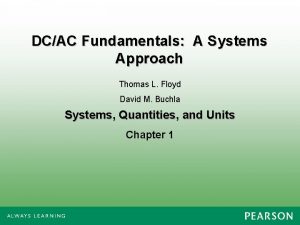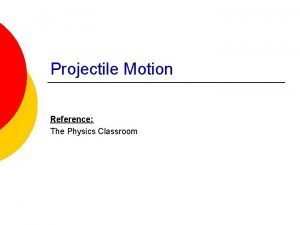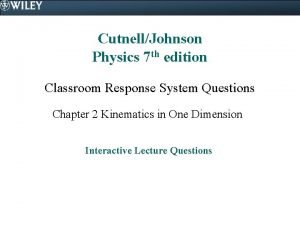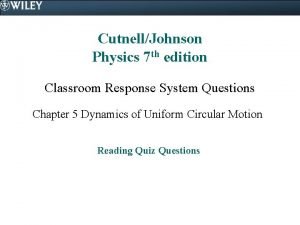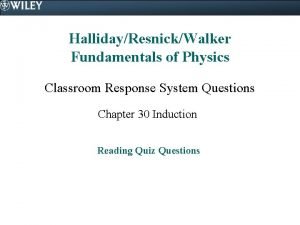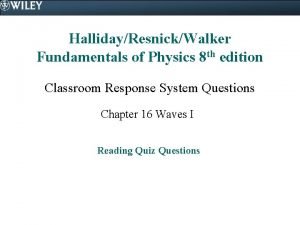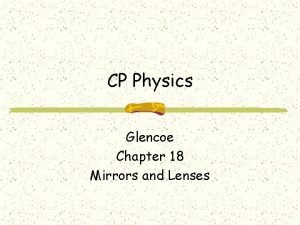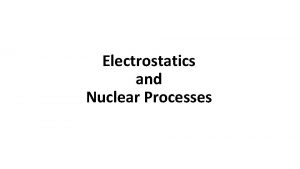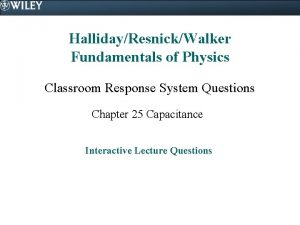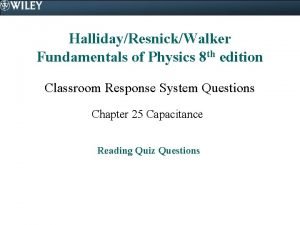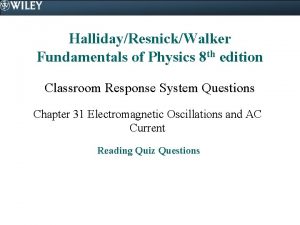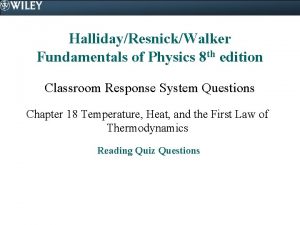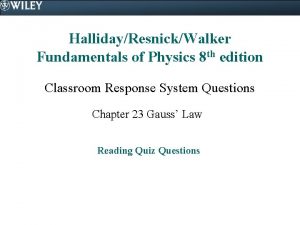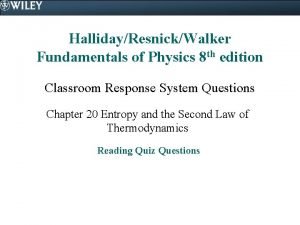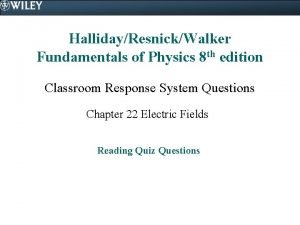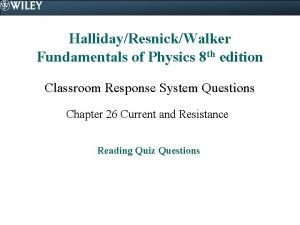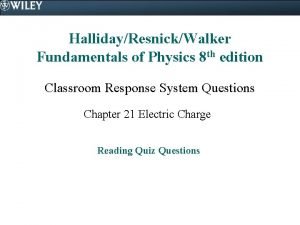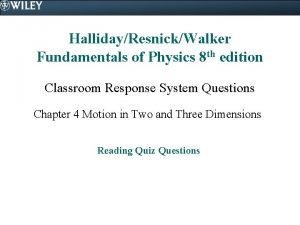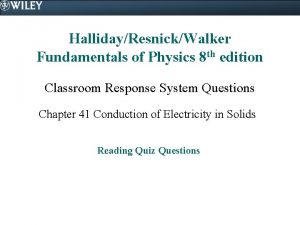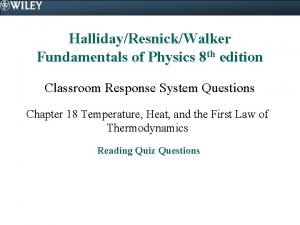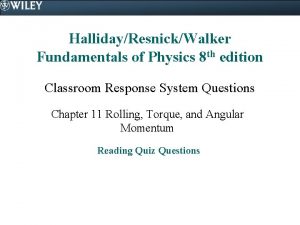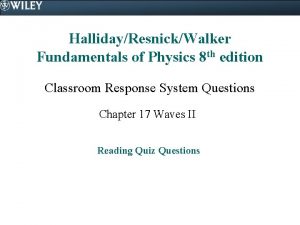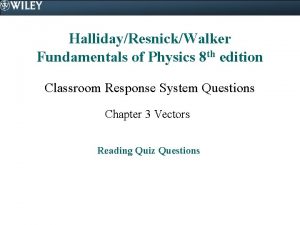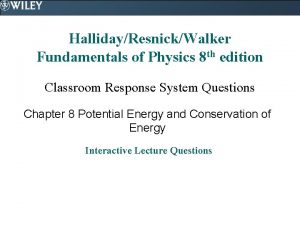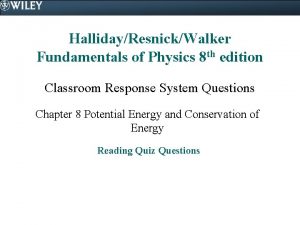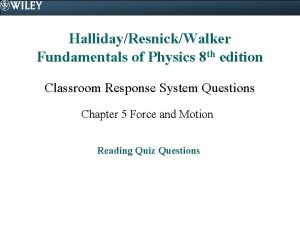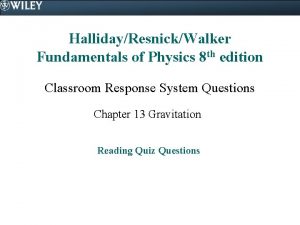HallidayResnickWalker Fundamentals of Physics 8 th edition Classroom





































- Slides: 37

Halliday/Resnick/Walker Fundamentals of Physics 8 th edition Classroom Response System Questions Chapter 25 Capacitance Reading Quiz Questions

25. 2. 1. The unit of capacitance is the farad (F). Which of the following combinations of units is equivalent to the farad? a) N/C b) V/C c) C/V d) J/C e) (N m)/(C s)

25. 2. 1. The unit of capacitance is the farad (F). Which of the following combinations of units is equivalent to the farad? a) N/C b) V/C c) C/V d) J/C e) (N m)/(C s)

25. 2. 2. Which one of the following choices is the unit for capacitance? a) sievert b) farad c) apgar d) garnet e) plethron

25. 2. 2. Which one of the following choices is the unit for capacitance? a) sievert b) farad c) apgar d) garnet e) plethron

25. 2. 3. What is capacitance? a) the amount of charge on a capacitor b) the amount of current flowing into or out of a capacitor c) the maximum amount of charge a capacitor can hold d) the amount of charge needed to produce a certain potential difference across a capacitor e) the amount of potential difference across a capacitor

25. 2. 3. What is capacitance? a) the amount of charge on a capacitor b) the amount of current flowing into or out of a capacitor c) the maximum amount of charge a capacitor can hold d) the amount of charge needed to produce a certain potential difference across a capacitor e) the amount of potential difference across a capacitor

25. 3. 1. Which one of the following is a primary consideration in determining the capacitance of a parallel-plate capacitor? a) the size and separation of the plates b) the potential difference across the plates c) the shape of the plates d) the particular materials used to fabricate the plates

25. 3. 1. Which one of the following is a primary consideration in determining the capacitance of a parallel-plate capacitor? a) the size and separation of the plates b) the potential difference across the plates c) the shape of the plates d) the particular materials used to fabricate the plates

25. 3. 2. When the distance between charged parallel plates of a capacitor is d, the potential difference is V. If the distance is decreased to d/2, how will the potential difference change, if at all? a) The new potential difference would be one-fourth of the previous value. b) The new potential difference would be one-half of the previous value. c) The new potential difference would be the same as the previous value. d) The new potential difference would be twice the previous value. e) The new potential difference would be four times the previous value.

25. 3. 2. When the distance between charged parallel plates of a capacitor is d, the potential difference is V. If the distance is decreased to d/2, how will the potential difference change, if at all? a) The new potential difference would be one-fourth of the previous value. b) The new potential difference would be one-half of the previous value. c) The new potential difference would be the same as the previous value. d) The new potential difference would be twice the previous value. e) The new potential difference would be four times the previous value.

25. 3. 3. When the distance between charged parallel plates of a capacitor is d, the capacitance is C. If the distance is increased to 2 d, how will the capacitance change, if at all? a) The new capacitance would be one-fourth of the previous value. b) The new capacitance would be one-half of the previous value. c) The new capacitance would be the same as the previous value. d) The new capacitance would be twice the previous value. e) The new capacitance would be four times the previous value.

25. 3. 3. When the distance between charged parallel plates of a capacitor is d, the capacitance is C. If the distance is increased to 2 d, how will the capacitance change, if at all? a) The new capacitance would be one-fourth of the previous value. b) The new capacitance would be one-half of the previous value. c) The new capacitance would be the same as the previous value. d) The new capacitance would be twice the previous value. e) The new capacitance would be four times the previous value.

25. 3. 4. For a cylindrical capacitor, the capacitance does not depend on which of the following values? a) the permittivity constant b) the radius of the inner conductor c) the amount of charge on the conductors d) the radius of the outer conductor e) the length of the cylinder

25. 3. 4. For a cylindrical capacitor, the capacitance does not depend on which of the following values? a) the permittivity constant b) the radius of the inner conductor c) the amount of charge on the conductors d) the radius of the outer conductor e) the length of the cylinder

25. 4. 1. Three capacitors are connected in parallel to a battery. How is the equivalent capacitance for this circuit determined? a) The equivalent capacitance is the sum of the three capacitances. b) The equivalent capacitance is the sum of the three capacitances divided by three. In other words, the equivalent capacitance is the average capacitance in the circuit. c) The potential drop across each capacitor is measured and multiplied by each capacitance before adding them together. d) A resistor is used to replace one capacitor at a time. Then, the current through the resistor is measured and used to determine the charge on each capacitor. The sum of the charges is then divided by the emf of the battery to find the equivalent capacitance. e) Unlike resistors, an equivalent capacitance cannot be found by any simple means.

25. 4. 1. Three capacitors are connected in parallel to a battery. How is the equivalent capacitance for this circuit determined? a) The equivalent capacitance is the sum of the three capacitances. b) The equivalent capacitance is the sum of the three capacitances divided by three. In other words, the equivalent capacitance is the average capacitance in the circuit. c) The potential drop across each capacitor is measured and multiplied by each capacitance before adding them together. d) A resistor is used to replace one capacitor at a time. Then, the current through the resistor is measured and used to determine the charge on each capacitor. The sum of the charges is then divided by the emf of the battery to find the equivalent capacitance. e) Unlike resistors, an equivalent capacitance cannot be found by any simple means.

25. 4. 2. Three capacitors are connected in series to a battery. Which one of the following statements concerning this situation is true? a) The amount of charge on each capacitor depends on its capacitance. If the capacitors have different capacitances, they will have differing amounts of charge on their plates. b) The equivalent capacitance is less than the sum of the individual capacitances. c) The battery must move more charge when the capacitors are connected in series than when connected in parallel. d) An equivalent capacitance can be found for capacitors connected in series, but not when they are connected in parallel. e) The equivalent capacitance is equal to the sum of the individual capacitances.

25. 4. 2. Three capacitors are connected in series to a battery. Which one of the following statements concerning this situation is true? a) The amount of charge on each capacitor depends on its capacitance. If the capacitors have different capacitances, they will have differing amounts of charge on their plates. b) The equivalent capacitance is less than the sum of the individual capacitances. c) The battery must move more charge when the capacitors are connected in series than when connected in parallel. d) An equivalent capacitance can be found for capacitors connected in series, but not when they are connected in parallel. e) The equivalent capacitance is equal to the sum of the individual capacitances.

25. 4. 3. How does the capacitance of two identical capacitors connected in series compare to that of one of the capacitors? a) The two capacitors connected in series have a larger capacitance. b) The two capacitors connected in series have the same capacitance. c) The two capacitors connected in series have a smaller capacitance.

25. 4. 3. How does the capacitance of two identical capacitors connected in series compare to that of one of the capacitors? a) The two capacitors connected in series have a larger capacitance. b) The two capacitors connected in series have the same capacitance. c) The two capacitors connected in series have a smaller capacitance.

25. 4. 4. How does the capacitance of two identical capacitors connected in parallel compare to that of one of the capacitors? a) The two capacitors connected in series have a larger capacitance. b) The two capacitors connected in series have the same capacitance. c) The two capacitors connected in series have a smaller capacitance.

25. 4. 4. How does the capacitance of two identical capacitors connected in parallel compare to that of one of the capacitors? a) The two capacitors connected in series have a larger capacitance. b) The two capacitors connected in series have the same capacitance. c) The two capacitors connected in series have a smaller capacitance.

25. 5. 1. A battery charges capacitor A until the potential difference between the two conductors of the capacitor is V. A second, identical capacitor, labeled B, is charged by another battery until the potential difference of capacitor B is 2 V. How does the stored energy of capacitor B compare to that of capacitor A? a) The stored energy in both capacitors is the same since the capacitance of both is the same. b) The stored energy of capacitor B is one-fourth that of capacitor A. c) The stored energy of capacitor B is one-half that of capacitor A. d) The stored energy of capacitor B is twice that of capacitor A. e) The stored energy of capacitor B is four times that of capacitor A.

25. 5. 1. A battery charges capacitor A until the potential difference between the two conductors of the capacitor is V. A second, identical capacitor, labeled B, is charged by another battery until the potential difference of capacitor B is 2 V. How does the stored energy of capacitor B compare to that of capacitor A? a) The stored energy in both capacitors is the same since the capacitance of both is the same. b) The stored energy of capacitor B is one-fourth that of capacitor A. c) The stored energy of capacitor B is one-half that of capacitor A. d) The stored energy of capacitor B is twice that of capacitor A. e) The stored energy of capacitor B is four times that of capacitor A.

25. 5. 2. Which of the following changes would result in an increase in the energy stored in a parallel-plate capacitor, assuming all other variables remain constant? a) insert an insulator between the plates b) increase the distance between the plates c) decrease the distance between the plates d) increase the area of the plates e) None of the changes listed above will change the energy stored in the capacitor.

25. 5. 2. Which of the following changes would result in an increase in the energy stored in a parallel-plate capacitor, assuming all other variables remain constant? a) insert an insulator between the plates b) increase the distance between the plates c) decrease the distance between the plates d) increase the area of the plates e) None of the changes listed above will change the energy stored in the capacitor.

25. 5. 3. Which of the following expressions gives the energy density between the plates of a parallel plate capacitor? a) b) c) d) e)

25. 5. 3. Which of the following expressions gives the energy density between the plates of a parallel plate capacitor? a) b) c) d) e)

25. 6. 1. What happens to a capacitor when an insulator is inserted between the two conductors of the capacitor? a) The capacitance of the capacitor increases. b) Electrons from the negative plate travel to the positive plate. c) The electric field inside the capacitor increases. d) There is no change to the capacitor. The insulator just keeps the two conductors separated. e) The insulator reduces the electric field between

25. 6. 1. What happens to a capacitor when an insulator is inserted between the two conductors of the capacitor? a) The capacitance of the capacitor increases. b) Electrons from the negative plate travel to the positive plate. c) The electric field inside the capacitor increases. d) There is no change to the capacitor. The insulator just keeps the two conductors separated. e) The insulator reduces the electric field between

25. 6. 2. The plates of a parallel plate capacitor are fully charged by connecting it to a battery. An insulator with a dielectric constant = 1. 0 is then inserted between the plates. What is the effect on the charge on the plates of the insertion of the insulator? a) The charge on the plates increases. b) The charge on the plates remains unchanged. c) The charge on the plates decreases.

25. 6. 2. The plates of a parallel plate capacitor are fully charged by connecting it to a battery. An insulator with a dielectric constant = 1. 0 is then inserted between the plates. What is the effect on the charge on the plates of the insertion of the insulator? a) The charge on the plates increases. b) The charge on the plates remains unchanged. c) The charge on the plates decreases.

25. 7. 1. How does the direction of the electric field within a dielectric inserted between the plates of a parallel plate capacitor compare to the direction of the electric field due to the charged plates? a) The direction within the dielectric is opposite to that due to the plates. b) The direction within the dielectric is parallel to that due to the plates. c) The direction within the dielectric is perpendicular to that due to the plates. d) There is no electric field inside the dielectric.

25. 7. 1. How does the direction of the electric field within a dielectric inserted between the plates of a parallel plate capacitor compare to the direction of the electric field due to the charged plates? a) The direction within the dielectric is opposite to that due to the plates. b) The direction within the dielectric is parallel to that due to the plates. c) The direction within the dielectric is perpendicular to that due to the plates. d) There is no electric field inside the dielectric.

25. 8. 1. When applying Gauss’ law for a capacitor containing a dielectric, which of the following statements is false? a) The electric field vector is multiplied by , the dielectric constant. b) The charge enclosed by the Gaussian surface includes both the free charge and the induced surface charges. c) Gauss’ law for a dielectric includes the ability to account for varying dielectric constant over the Gaussian surface. d) Gauss’ law for a dielectric is the most general form of Gauss’ law. e) Gauss’ law for a dielectric can be applied to many types of capacitors.

25. 8. 1. When applying Gauss’ law for a capacitor containing a dielectric, which of the following statements is false? a) The electric field vector is multiplied by , the dielectric constant. b) The charge enclosed by the Gaussian surface includes both the free charge and the induced surface charges. c) Gauss’ law for a dielectric includes the ability to account for varying dielectric constant over the Gaussian surface. d) Gauss’ law for a dielectric is the most general form of Gauss’ law. e) Gauss’ law for a dielectric can be applied to many types of capacitors.
 University physics with modern physics fifteenth edition
University physics with modern physics fifteenth edition Fundamentals of information systems 9th edition
Fundamentals of information systems 9th edition Fundamentals of information systems 9th edition
Fundamentals of information systems 9th edition Fluid mechanics fundamentals and applications 3rd edition
Fluid mechanics fundamentals and applications 3rd edition Digital fundamentals by floyd 10th edition
Digital fundamentals by floyd 10th edition Machining fundamentals 10th edition
Machining fundamentals 10th edition Fundamentals of organizational communication 9th edition
Fundamentals of organizational communication 9th edition Fundamentals of organizational communication 9th edition
Fundamentals of organizational communication 9th edition Fundamentals of corporate finance 3rd canadian edition
Fundamentals of corporate finance 3rd canadian edition Digital fundamentals floyd 10th edition
Digital fundamentals floyd 10th edition Digital fundamentals by floyd
Digital fundamentals by floyd Dc/ac fundamentals 1st edition
Dc/ac fundamentals 1st edition Computer security fundamentals 4th edition
Computer security fundamentals 4th edition Management fundamentals 8th edition
Management fundamentals 8th edition Fundamentals of information systems 9th edition
Fundamentals of information systems 9th edition Fundamentals of corporate finance canadian edition
Fundamentals of corporate finance canadian edition Fundamentals of corporate finance fifth edition
Fundamentals of corporate finance fifth edition Corporate finance 6th edition
Corporate finance 6th edition Abnormal psychology comer 9th edition
Abnormal psychology comer 9th edition Fundamentals of information systems 9th edition
Fundamentals of information systems 9th edition Thermal resistance formula
Thermal resistance formula The fundamentals of political science research 2nd edition
The fundamentals of political science research 2nd edition Sourima mal
Sourima mal Using mis (10th edition) 10th edition
Using mis (10th edition) 10th edition Zulily case study
Zulily case study Hewitt
Hewitt Physics classroom
Physics classroom Centripetal acceleration physics classroom
Centripetal acceleration physics classroom Hanging sign problem physics
Hanging sign problem physics Physics classroom
Physics classroom Consider the three equations below.
Consider the three equations below. Physics classroom lenses and mirrors
Physics classroom lenses and mirrors Electrostatics physics classroom
Electrostatics physics classroom Gauss law physics classroom
Gauss law physics classroom Physics classroom magnetic field
Physics classroom magnetic field Capacitance physics classroom
Capacitance physics classroom Physics classroom kinetic energy
Physics classroom kinetic energy Farad is equivalent to
Farad is equivalent to











